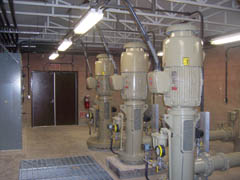-
Published: Aug 27, 2013 | 15:36 PM
Heavy Lifters at IRWD – Pump Stations
 Not many of us think about how the water gets to our faucets. You turn on the tap and the water comes out, right? But how does that happen?
Not many of us think about how the water gets to our faucets. You turn on the tap and the water comes out, right? But how does that happen?
“For many of our customers, water is delivered by pump stations that bring water to their neighborhoods,” said Tom Roberts, Operations Manager, for Irvine Ranch Water District.
Pumps not only provide the needed pressure for areas in higher elevations, they also deliver water to the storage reservoirs that serves the neighborhoods for regular and emergency use.
Pumps may be operated by either electric or gas-powered motors. If a home is at a higher elevation, chances are the water coming from your faucets went through two or more pump stations.
Water is a heavy commodity – each gallon weighs just a little more than eight pounds. In order to provide the correct pressure, it is typically lifted 100 feet above the home. Every day, the average American pours, flushes or sprinkles 40-130 gallons of water per day, so imagine the energy needed to carry that water up a 100-foot ladder.
Pumps are selected to perform this lifting in the most efficient manner. IRWD’s pumps need to have adequate horsepower so that they don’t run continuously. They can then be turned off when electricity costs more, typically in the afternoon on hot days.
Pump stations may have two or more units to meet daily demands and there is usually a backup unit. In the foothill areas prone to wildfires, generators have been added to the pump stations to ensure the necessary fire flow in the event of a power outage.
IRWD has 57 pump stations throughout its 181-square-mile service area. Special instrumentation and telemetry monitors the pumps around the clock, providing valuable information to the operators. Pumps have protective devices that shut them down to prevent internal damage and water loss if there is a blockage or break in a water main.
Operators are notified through the SCADA (supervisory control and data acquisition) system, which gives them an alarm on their computers. Often, adjustments can be made.


 Not many of us think about how the water gets to our faucets. You turn on the tap and the water comes out, right? But how does that happen?
Not many of us think about how the water gets to our faucets. You turn on the tap and the water comes out, right? But how does that happen?